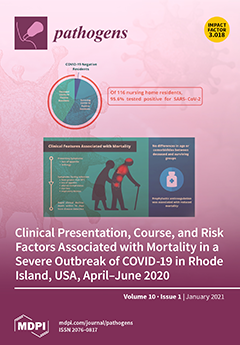We report the emergence of an isolate belonging to the sequence type (ST)131-
Escherichia coli high-risk clone with ceftazidime-avibactam resistance recovered from a patient with bacteremia in 2019. Antimicrobial susceptibility was determined and whole genome sequencing (Illumina-NovaSeq6000) and cloning experiments were performed to
[...] Read more.
We report the emergence of an isolate belonging to the sequence type (ST)131-
Escherichia coli high-risk clone with ceftazidime-avibactam resistance recovered from a patient with bacteremia in 2019. Antimicrobial susceptibility was determined and whole genome sequencing (Illumina-NovaSeq6000) and cloning experiments were performed to investigate its resistance phenotype. A KPC-3-producing
E. coli isolate susceptible to ceftazidime-avibactam (MIC = 0.5/4 mg/L) and with non-wild type MIC of meropenem (8 mg/L) was detected in a blood culture performed at hospital admission. Following 10-days of standard ceftazidime-avibactam dose treatment, a second KPC-producing
E. coli isolate with a phenotype resembling an extended-spectrum β-lactamase (ESBL) producer (meropenem 0.5 mg/L, piperacillin-tazobactam 16/8 mg/L) but resistant to ceftazidime-avibactam (16/4 mg/L) was recovered. Both
E. coli isolates belonged to ST131, serotype O25:H4 and sublineage H30R1. Genomics analysis showed a
core genome of 5,203,887 base pair with an evolutionary distance of 6 single nucleotide polymorphisms. A high content of resistance and virulence genes was detected in both isolates. The novel KPC-49 variant, an Arg-163-Ser mutant of
blaKPC-3, was detected in the isolate with resistance to ceftazidime-avibactam. Cloning experiments revealed that
blaKPC-49 gene increases ceftazidime-avibactam MIC and decreases carbapenem MICs when using a porin deficient
Klebsiella pneumoniae strain as a host. Both
blaKPC-3 and
blaKPC-49 genes were located on the transposon Tn
4401a as a part of an IncF [F1:A2:B20] plasmid. The emergence of novel
blaKPC genes conferring decreased susceptibility to ceftazidime-avibactam and resembling ESBL production in the epidemic ST131-H30R1-
E. coli high-risk clone presents a new challenge in clinical practice.
Full article






